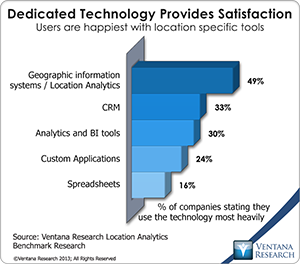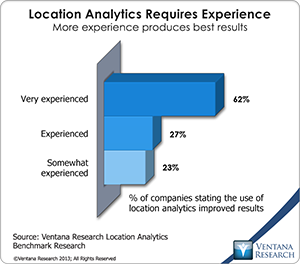Our latest benchmark research into the market for location analytics software finds significant demand for location-related technology that can improve business outcomes and generate relevant information for various types of users. Location analytics is an extension of business analytics that can enhance the sophistication of data and processes by adding a geographic context.
Our latest benchmark research into the market for location analytics software finds significant demand for location-related technology that can improve business outcomes and generate relevant information for various types of users. Location analytics is an extension of business analytics that can enhance the sophistication of data and processes by adding a geographic context.
My last analyst perspective on this topic discussed the business value of insights based on geography and what organizations are doing to advance their efforts here. Our research also shows, however, that most still lack satisfaction and confidence in using the technology. Just 12 percent of all participants said they are very satisfied with the location information and analytics available in their organization. Further analysis shows that satisfaction increases with use of a dedicated application for location analytics: 71 percent of those are satisfied or very satisfied, substantially more than those using location analytics within a BI tool (22%); findings are similar for both B2B and B2C use. We find similar levels of confidence in the quality of location information: 15 percent of those using a dedicated application are very confident in their location analytics. Confidence in the reliability of such information is essential to more organizations adopting location analytics.
 One cause of limited satisfaction and confidence appears to be the difficulty of analyzing information that has a location context. Two-thirds of organizations said doing so requires significant effort or some effort, and 17 percent said that is very difficult or they cannot do it. Thus it is not surprising that about three in fiveorganizations plan to change the way they use location information in the next 12 to 18 months. For more than 40 percent each, that change is driven by efforts to improve processes: a new initiative to improve information and decision-making (51%), a need to improve business-to-business planning and collaboration (50%), the desire to promote operational efficiency (49%) and as part of a wider analytics and business intelligence initiative (44%). Participants with IT titles most often identified as the driver a new initiative improving information and decision-making (61%), as did those from the services (69%) and government (63%) industry sectors; those working in lines of business insisted more on seeking change to improve B2B planning and collaboration (54%). The need for improvement shows that organizations recognize a potentially important role for location analytics in various business processes, from information use to decision-making.
One cause of limited satisfaction and confidence appears to be the difficulty of analyzing information that has a location context. Two-thirds of organizations said doing so requires significant effort or some effort, and 17 percent said that is very difficult or they cannot do it. Thus it is not surprising that about three in fiveorganizations plan to change the way they use location information in the next 12 to 18 months. For more than 40 percent each, that change is driven by efforts to improve processes: a new initiative to improve information and decision-making (51%), a need to improve business-to-business planning and collaboration (50%), the desire to promote operational efficiency (49%) and as part of a wider analytics and business intelligence initiative (44%). Participants with IT titles most often identified as the driver a new initiative improving information and decision-making (61%), as did those from the services (69%) and government (63%) industry sectors; those working in lines of business insisted more on seeking change to improve B2B planning and collaboration (54%). The need for improvement shows that organizations recognize a potentially important role for location analytics in various business processes, from information use to decision-making.
A range of technologies can be used for location analytics,  but not all options work equally well. Today nearly half (49%) of organizations use spreadsheets heavily for analyzing information that includes location data; significantly fewer use other tools heavily – custom applications (36%), analytic or BI tools (34%) and a geographic information system (GIS, 23%). Many organizations use business applications heavily for analyzing this type of information, most often customer relationship management (CRM, 28%), supply chain management (16%) and enterprise asset management (14%) systems. Yet heavy users of a GIS or a dedicated application are the ones most often very satisfied (49%), and heavy users of spreadsheets are very satisfied least often (16%). Among those saying that the use of location analytics has improved their results, spreadsheet users ranked last (35%), far behind users of a GIS (55%) and analytic or BI tools (49%). Organizations that use a dedicated tool for location analytics (49%) are the most satisfied significantly more than those that use only spreadsheets (16%).
but not all options work equally well. Today nearly half (49%) of organizations use spreadsheets heavily for analyzing information that includes location data; significantly fewer use other tools heavily – custom applications (36%), analytic or BI tools (34%) and a geographic information system (GIS, 23%). Many organizations use business applications heavily for analyzing this type of information, most often customer relationship management (CRM, 28%), supply chain management (16%) and enterprise asset management (14%) systems. Yet heavy users of a GIS or a dedicated application are the ones most often very satisfied (49%), and heavy users of spreadsheets are very satisfied least often (16%). Among those saying that the use of location analytics has improved their results, spreadsheet users ranked last (35%), far behind users of a GIS (55%) and analytic or BI tools (49%). Organizations that use a dedicated tool for location analytics (49%) are the most satisfied significantly more than those that use only spreadsheets (16%).
A look at the capabilities necessary for effective location analytics indicates why tools designed for the purpose get better results. More than three in five organizations said three basic capabilities are important: geographic representation of data, visual metrics associated with locations on a map, and selecting and analyzing locations on a map. One-half to one-third said interacting with maps and locations for further analysis, determining distance and drive time, and adding layers to maps are important. All of these basic capabilities are the building blocks for conducting specific analytics that can identify or recommend actions from the mashup of data about a location or to provide insights to guide decisions based on location-specific indicators.
Another technology approach used most frequently is business intelligence (BI). These tools are designed for reporting, creating dashboards and general access to analytic information such as metrics. BI tools and processes are established in both IT departments and lines of business, and location information can further enhance BI efforts. Nearly half (48%) of participants in this research ranked business intelligence interfaces as the most important to integrate with other enterprise software; custom interfaces was a distant second at only 13 percent. IT participants (55%) put BI first more often than did those in business (44%), and manufacturing (55%) ranked it higher than other industries. BI also is the application most often integrated with location analytics (45%), even more so in the largest companies by number of employees (56%) and by annual revenue (65%). In terms of planning and developing a strategy to use location analytics with other systems, most intend to integrate it with marketing automation (33%), sales force automation (30%) and enterprise content management (also 30%).
However, the research also finds impediments in using BI and location analytics together. Almost half (46%) of participating organizations said that integrating the two requires significant effort; another 16 percent said doing that is very difficult and requires substantial time or that they have no practical way to do it. On a positive note, integration of these two technologies has advanced significantly in the last several years, and it is easier to exchange data and add it to presentations. In addition, organizations that use business intelligence to conduct location analytics reported benefits, particularly improving the customer experience (21%) and gaining competitive advantage (20%). More than three in five companies that use BI with location analytics are very satisfied (17%) or satisfied (44%) with theinformation and analytics they have available. Thus the research clearly shows that integrating location information into business intelligence can deliver value.
Looking at location information in a broader sense we find many organizations using consumer mapping to plot data quickly, predominantly free software such as from Google (which 45% use) and Microsoft (31%). The research also reveals that while almost one-third (31%) have used these for enterprise needs, only 8 percent are very satisfied with them. Like personal productivity tools, these tools can help in individual tasks like driving instructions and plotting locations for quick geographic placement, but they lack task support and operational or specific analytical context that requires secure, integrated access to enterprise systems. Free and easy access makes them attractive, but they do not provide enough capabilities for skilled workers to use in complex business tasks.
As deployments grow, so does the need to integrate and adapt location analytics to other technologies. For example, one in five research participants said mobile technology is critical for improving location analytics, as did smaller numbers for cloud computing (15%), big data (15%) and collaboration (8%). Ways of deploying location analytics also are changing, as more organizations realize that buying and installing the software on-premises (which 35% prefer) is not the only approach; nearly as many (33%) want to access it on demand through software as a service (SaaS). Very large companies by number of employees (44%) and annual revenue (39%) have the strongest bias for on-demand deployment, as does manufacturing (43%) among industry sectors. Exploiting the full potential of big data investments, whether representing machine data or customer locations, is a prime example of where location analytics can help use data effectively. The research strongly suggests that location analytics will have a place in evolving business technology environments and that broader use of innovative technology will extend the value of this investment also.
 However an organization deploys location analytics, the research shows that experience in using it is critical to success. Half of participating organizations have deployed location-focused technology, and the percentage is highest among very large companies by number of employees (56%) and annual revenue (67%). Almost two-thirds (62%) of all companies that have the most experience said location analytics has helped improve results significantly; among those who are somewhat experienced just 23 percent said this.
However an organization deploys location analytics, the research shows that experience in using it is critical to success. Half of participating organizations have deployed location-focused technology, and the percentage is highest among very large companies by number of employees (56%) and annual revenue (67%). Almost two-thirds (62%) of all companies that have the most experience said location analytics has helped improve results significantly; among those who are somewhat experienced just 23 percent said this.
Organizations of course expect to realize important benefits from software investments. The top five benefits being sought from location analytics are to improve the customer experience and customer satisfaction; gain competitive advantage; improve access to and value of existing information; improve organizational alignment and coordination; and deliver products and services faster. Organizations that use a dedicated technology focus most on gaining competitive advantage (21%) and delivering products and services faster (16%). Investment in a dedicated tool for location analytics can increase the value of an organization’s information and analytics, which improves with experience in using the technology. We recommend that organizations develop a location-specific component in their agenda for analytics. If you want to learn more on the value and potential of technology in location analytics our community is available to help with more depth in best practices and insights on this topic.






